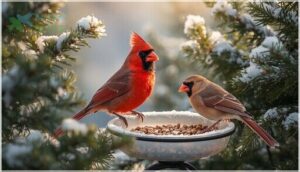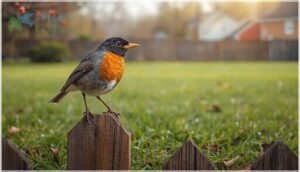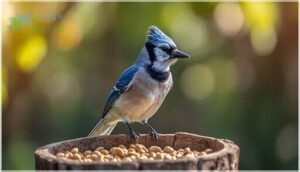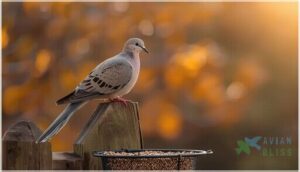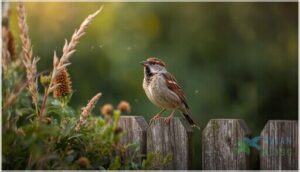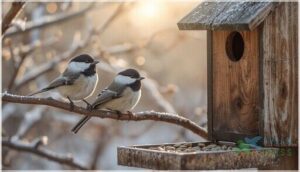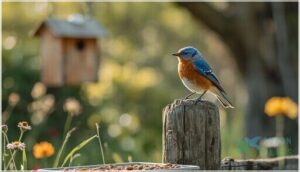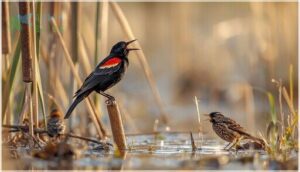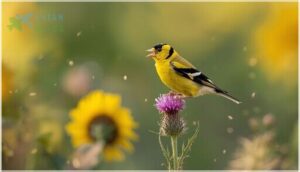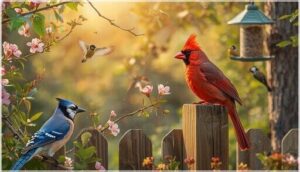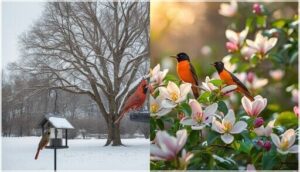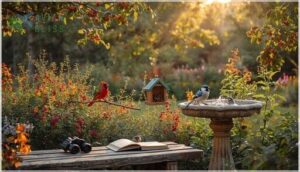This site is supported by our readers. We may earn a commission, at no cost to you, if you purchase through links.
Your backyard is probably hosting more drama than you realize. Right now, Northern Cardinals are defending their territory with sharp chip notes, Blue Jays are running protection rackets at your feeders, and American Robins are yanking earthworms from your lawn with surprising force.
Ohio sits in a sweet spot where northern and southern bird ranges overlap, which means your yard can attract over 50 different species throughout the year. Some stick around through blizzards, others show up only when the weather suits them, and a few just pass through on their way to somewhere else.
Learning to recognize these backyard birds of Ohio transforms your morning coffee routine into a front-row seat to survival, courtship, and the changing seasons.
Table Of Contents
- Key Takeaways
- Common Backyard Birds in Ohio
- Identifying Ohio’s Backyard Birds
- Attracting Birds to Your Ohio Yard
- Seasonal Changes and Migratory Birds
- Birdwatching Tips and Conservation Efforts
- Frequently Asked Questions (FAQs)
- What are the most common backyard birds in Ohio?
- Where do birds live in Ohio?
- What birds live in Columbus Ohio?
- What birds live in the Buckeye State?
- Where do Bluebirds live in Ohio?
- Where do brown-headed cowbirds live in Ohio?
- How do I identify a bird in my yard?
- What is the most common birds in Ohio?
- What are the little GREY birds in Ohio?
- What is killing birds in my backyard?
- Conclusion
Key Takeaways
- Ohio’s geographic location creates a birding sweet spot where northern and southern species overlap, giving backyards access to over 50 species year-round, including both permanent residents like Northern Cardinals and seasonal migrants like Ruby-throated Hummingbirds.
- Successful bird identification relies on observing size, shape, and behavior patterns first—body proportions, beak shapes, and foraging habits reveal more about a species than color alone, especially during seasonal plumage changes.
- Transforming your yard into a bird magnet requires native plantings (oaks support 550+ caterpillar species that feed songbirds), clean water sources, and proper feeder hygiene every 7-14 days to prevent disease outbreaks that devastate populations.
- Ohio’s backyard birdwatching contributes $12.5 billion to the state economy while supporting conservation through citizen science projects like eBird, where over 100,000 participants document 350+ species annually to inform protection strategies.
Common Backyard Birds in Ohio
You don’t need to look far to find fascinating birds right in your own backyard. Ohio’s location along major migration routes means you’ll see both year-round residents and seasonal visitors throughout the year.
Here are ten species you’re most likely to spot at your feeders, in your trees, or hopping across your lawn.
Northern Cardinal
You’ll spot Northern Cardinals year-round in Ohio—those vibrant red males are hard to miss. Females wear softer tan feathers with red accents, but both sport that signature crest. These backyard birds stick around all seasons, hopping through dense shrubs and cracking sunflower seeds at your feeder.
They’re territorial during nesting season, with males fiercely defending their four-acre patch while raising multiple broods. The Northern Cardinal is protected under the bird conservation laws to guarantee their population remains stable.
American Robin
American Robins are everywhere in Ohio—those orange-red breasts and cheerful “cheerily” calls make them instantly recognizable. You’ll find them yanking earthworms from lawns during spring and summer, then switching to berries when cold weather hits. They’re partial migrants, so some stick around all winter while others head south. Watch for their mud-cup nests tucked in tree branches come breeding season.
Robin Migration Patterns and behaviors:
- These backyard birds follow the 37-degree temperature line during spring migration, sometimes traveling in flocks of 10 to 60,000 individuals
- About 40% of nests successfully fledge young, with females often raising three broods per season
- Their diet shifts dramatically—insects and worms dominate spring menus, while berries make up 60% of their year-round intake
- Ohio’s invasive honeysuckle has created abundant winter food sources, allowing larger populations to overwinter in urban areas
- Conservation efforts focus on reducing pesticide poisoning risks to protect these birds.
Blue Jay
You’ll recognize Blue Jays by their bright blue-and-white feather coloration and spiky crest—a standout among Ohio bird species. These bold backyard birding favorites love peanuts and sunflower seeds at your feeders.
Their nesting patterns run from mid-March through July, with both parents building nests in trees. Watch their jay habitat needs: they prefer wooded edges and suburban yards, storing nuts they’ll retrieve later during winter foraging.
Mourning Dove
You’ll hear the Mourning Dove before you spot it—that soft, melancholy cooing is unmistakable among Ohio bird species. These sleek birds show subtle gray-brown feather patterns with black spots on their wings.
They’re ground feeders who love white millet and cracked corn at your feeders.
Watch their flocking behavior during dove migration each fall, when Ohio’s 4 million doves gather before heading south.
Song Sparrow
You’ll find Song Sparrows year-round in Ohio’s brushy edges and gardens—just follow the bold, buzzy trills. Look for their streaky brown plumage and central breast spot.
These adaptable backyard birds shift from an 86% seed diet in winter to insects during the summer breeding season.
With 130 million across North America and a stable conservation status, they’re reliable companions for Ohio bird-watching enthusiasts.
Tufted Titmouse
You can spot the Tufted Titmouse year-round in Ohio—98.7% of counties host these charismatic backyard birds. Look for their gray crest and peach flanks at your feeder, where they’ll grab sunflower seeds and practice food hoarding within 130 feet.
With 8 million across North America and a stable conservation status, they’re reliable companions for bird watching enthusiasts exploring Ohio birds and nesting habits.
Black-capped and Carolina Chickadee
Ohio is home to two chickadee species, and their habitats depend on the county. Black-capped Chickadees inhabit northern Ohio, while Carolina Chickadees have expanded northward, creating a narrow hybrid zone along U.S. Highway 30. These birds are known for their cheerful “chick-a-dee-dee-dee” calls, often heard at feeders year-round, where they collect sunflower seeds and store them nearby.
- Black-capped birds sing a two-note “fee-bee,” while Carolinas offer four notes
- Both need native plants—70% biomass minimum—for successful nesting habits
- They’re cavity nesters who’ll happily use your nest boxes
Both species share similar nesting requirements, relying on native plants for at least 70% of their biomass. As cavity nesters, they readily utilize nest boxes provided by humans.
Eastern Bluebird
Eastern Bluebirds bring vivid sky-blue feather coloration to Ohio backyards year-round. You’ll spot these backyard birds perching low, watching for insect foraging opportunities—crickets, beetles, and grasshoppers make up their diet.
Their conservation status has improved dramatically since the 1970s thanks to nest box installation programs across the state.
Bird watching enthusiasts can attract them with mealworms, and proper bird species identification helps distinguish them during bluebird migration periods.
Red-winged Blackbird
Red-winged Blackbirds arrive as early as mid-April, announcing spring with their territorial calls. These backyard birds in Ohio breed in marshes and wetlands, where males display bright red shoulder patches.
For bird watching enthusiasts, habitat preservation protects their nesting patterns—females may raise up to three clutches per season.
Their feeding habits shift from insects during breeding to waste grains in winter, making bird species identification easier across seasons.
American Goldfinch
The American Goldfinch brightens Ohio yards year-round with its bouncing flight and cheerful calls. Males wear vivid yellow during breeding season, while their diet focuses almost entirely on seeds—especially thistle and sunflower hearts from bird feeders.
These Ohio birds nest unusually late, starting in July when thistledown provides soft lining. Their conservation status remains stable, making backyard birding rewarding for species identification enthusiasts practicing proper feather care observations.
Identifying Ohio’s Backyard Birds
Spotting a flash of red or blue in your yard is exciting, but knowing exactly which bird you’re looking at takes a bit of practice. The good news is that Ohio’s backyard birds have clear tells—size, color, behavior, and sound—that make identification easier than you might think.
Here’s what to watch for when you’re trying to put a name to that feathered visitor.
Size and Shape Clues
When you’re trying to nail bird species identification, size and shape clues are your secret weapon. Body proportions, wing span, tail length, and beak shapes tell you more than color ever could. Even feather texture matters—it’s like each bird carries its own fingerprint.
- Cardinals show chunky builds with thick, seed-cracking beaks (8-9 inches long)
- Robins stretch 9-11 inches with balanced proportions perfect for ground hopping
- Chickadees look like adorable fluff balls—small, rounded, impossible to miss
- Mourning Doves sport plump bodies but wear delicate, pointed tails
- Blue Jays rock that bold crest and slightly hooked beak (nearly 12 inches)
Color Patterns and Markings
Once you’ve locked down size and shape, color patterns and markings seal the deal on bird identification. Male Northern Cardinals flash vivid red across 95% of their bodies with bold black masks, while females rock pale brown with red wing accents. Blue Jays show off that striking blue-and-white combo—light scattering creates the color, not pigment.
Feather patterns, wing markings, and beak colors reveal each avian species’ signature look instantly.
Behavior and Habitat Preferences
Beyond color and markings, bird behavior and habitat choices help you nail down species fast. Northern Cardinals stick to dense shrubs and woodland edges, defending territories vocally. Red-winged Blackbirds dominate wetlands and marshes, males flashing those epaulets aggressively. Mourning Doves adapt everywhere—suburban gardens, farm fields, wooded edges. Watching foraging strategies, nesting behaviors, and territorial defense patterns reveals which bird you’re spotting.
Key habitat selection and behavior patterns:
- Song Sparrows prefer brushy thickets with scattered trees, using peripheral yard shrubs for cover
- Chipping Sparrows favor semi-open suburban spots, rarely straying far from small trees or hiding sites
- American Goldfinches postpone nesting until mid-summer, timing breeding with peak seed availability
- Eastern Bluebirds commonly use nest boxes in open country, nesting anywhere from ground level to 50 feet high
- Red-winged Blackbird males return by mid-March, establishing territories before females arrive for breeding
Bird Songs and Calls
You’ll recognize many backyard birds by ear long before you spot them. Northern Cardinals whistle clear two-second phrases from treetops, repeating around 16 distinct song patterns for territory defense. American Robins deliver cheerful phrases at dawn and dusk, while Blue Jays mimic hawk calls with 85% accuracy.
Song Sparrows showcase regional dialects, and goldfinches chirp “potato-chips” in flight, matching each wingbeat.
Seasonal Plumage Changes
Molt patterns reveal surprising changes in your backyard birds. American Goldfinches swap bright yellow for drab brown by late summer, while robins finish molting by mid-September with duller breasts. You’ll notice these seasonal displays:
- Male Northern Cardinals keep red plumage year-round with slight back dulling
- Goldfinch bills shift from gray-brown to orange before July breeding
- Red-winged Blackbirds complete feather replacement before fall migration
- Juvenile robins develop spotted breasts until their first molt
These plumage adaptations help with bird identification across seasons.
Attracting Birds to Your Ohio Yard
Once you’ve learned to identify your backyard visitors, the next step is turning your yard into a place they’ll actually want to stick around. You don’t need a sprawling estate or fancy equipment—just a few thoughtful changes can make all the difference.
Here’s what works to bring more birds to your doorstep.
Choosing Bird Feeders and Food
Your feeder setup can make or break your bird watching in Ohio. Platform feeders draw the widest crowd—68% of backyards use them—while tube feeders target finches and chickadees.
Black oil sunflower seed works for over 90% of backyard birds, and suet feeders keep woodpeckers happy in winter.
Mix your feeding strategies and seed mixtures to see more species at your bird feeders.
Planting Native Trees and Shrubs
Native plantings transform your backyard into a genuine bird sanctuary. Here’s why tree selection matters:
- Oak trees sustain over 550 butterfly and moth species—caterpillars that songbirds need for successful breeding
- River birch and dogwood attract woodpeckers and provide year-round cover
- Viburnum shrubs deliver fall fruit when migrating birds need energy most
- Native perennials like black-eyed Susan complete the ecosystem services your habitat restoration provides
Suburban yards with native plants host eight times more thrushes and tanagers than traditional landscapes—that’s backyard birding that genuinely sustains bird conservation.
Providing Water Sources
Water transforms your backyard into a bird magnet—especially when temperatures drop. A simple bird bath attracts up to 30 species during summer droughts, while heated sources keep cardinals and blue jays hydrated through Ohio’s brutal winters.
You’ll want moving water from a dripper to double your visitors and slash mosquito breeding. Clean weekly, refill every few days, and watch your backyard birding explode.
Creating Shelter and Nesting Spots
Your backyard habitat restoration efforts can boost bluebird populations by 60% when you install properly designed nest boxes. Here’s how to create shelter that actually works for Ohio’s backyard birds:
- Mount birdhouses 4-6 feet high in open areas with afternoon shade—eastern bluebirds and chickadees show 58% occupancy rates with smart birdhouse placement
- Plant dense native shrubs like viburnum and dogwood to triple nesting attempts for robins and cardinals
- Leave brush piles and deadwood to increase sparrow and wren nest density by 30%
These wildlife-friendly habitats support bird nesting habits while creating a bird-friendly yard that welcomes cavity-nesters and songbirds alike.
Maintaining a Safe Environment
You can’t create a safe haven without addressing the threats that matter most. Clean your bird feeders every two weeks with a bleach solution to prevent disease issues like salmonella.
Position feeders in open areas for predator control, and apply window safety decals to reduce collisions.
These feeder hygiene practices support bird conservation while making your backyard birding setup truly wildlife-friendly.
Seasonal Changes and Migratory Birds
Ohio’s bird population shifts dramatically with the seasons, and understanding these changes will help you know who’s visiting your feeders at any given time. Some species stick around all year, while others show up only during specific seasons or pass through during migration.
Let’s break down which birds you’ll see when, so you can better predict and enjoy the rhythms of your backyard.
Year-Round Resident Species
You’ll find reliable companions at your feeders all winter long. Northern Cardinals, American Goldfinches, and Black-capped Chickadees stick around through Ohio’s coldest months, showing impressive seasonal adaptation.
Tufted Titmice and Downy Woodpeckers also remain year-round, thriving with consistent year-round feeding. These resident species have mastered urban birding environments, making bird habitat creation worthwhile even when temperatures drop. Their resident bird behavior offers daily viewing opportunities.
Summer Breeding Birds
When spring warms up, your backyard birding shifts into high gear. Summer breeding birds like scarlet tanagers and indigo buntings arrive from Central America, turning Ohio into nesting central for over 180 species annually. You’ll spot these neotropical migrants from mid-May through August, busily raising their young.
- Blue-winged warblers claim 8% of their global breeding population right here
- Cerulean warblers find prime breeding habitats in Ohio’s forests, representing 11% worldwide
- Eastern bluebirds and gray catbirds become backyard regulars during nesting season
Conservation efforts and summer feeding stations support these bird species throughout their critical reproductive period.
Winter Visitors
When cold weather settles in, your feeders become survival hubs. Dark-eyed Juncos, American Goldfinches, and Black-capped Chickadees stick around through snowfall effects that bury natural food. Northern Cardinals and Downy Woodpeckers show up reliably, while bird irruptions occasionally bring surprise visitors.
Smart feeder strategies—offering sunflower seeds and suet—help these hardy species navigate Ohio’s toughest winter habitats.
Spring and Fall Migrants
Migration patterns shift dramatically twice a year, bringing waves of warblers, thrushes, and vireos through your yard. You’ll spot the biggest numbers in late April through May, then again throughout September when fall migration peaks.
- Ruby-throated hummingbirds and indigo buntings arrive mid-May
- Magnolia and blackpoll warblers pass through in massive flocks
- Broad-winged hawks soar overhead during September pushes
- Over 150 million birds move through Ohio each spring
Bird tracking shows these seasonal shifts happen fast—watch closely or you’ll miss them.
Birdwatching Tips and Conservation Efforts
Watching birds in your backyard is more than just a hobby—it’s a chance to contribute to their survival. With over 2.4 million Ohioans participating in birdwatching and wildlife-related activities generating $12.5 billion for the state’s economy, your efforts truly matter.
Backyard birdwatching in Ohio isn’t just a hobby—it’s a $12.5 billion contribution to conservation and the state’s economy
Here’s how you can make your yard a safer haven while becoming part of a larger conservation movement.
Responsible Bird Feeding Practices
You can’t just fill a feeder and forget it—bird health depends on your routine. Clean feeders every 7 to 14 days with a 10% bleach solution to prevent disease outbreaks that have devastated songbird populations.
Choose fresh, high-quality seed like black oil sunflower to minimize waste and mold.
Smart feeding strategies, including diverse feeder types and native plantings, support thriving backyard birds while protecting Ohio’s wildlife.
Preventing Window Collisions
Windows can become invisible death traps for your backyard visitors. Bird-friendly solutions—like window films with patterns birds can see—reduce collisions by up to 71%, turning glass into avian safety zones. Urban planning now embraces collision prevention measures:
- Apply Feather Friendly markers to high-risk glass surfaces
- Install screens or decals spaced no more than 2 inches apart
- Position feeders within 3 feet of windows
These backyard birding tips support wildlife conservation in Ohio while enhancing bird watching opportunities.
Participating in Citizen Science
You can join over 100,000 Ohioans who’ve already logged eBird observations—documenting 350+ species annually through real-time citizen science.
Projects like FeederWatch and the Great Backyard Bird Count transform your backyard bird watching into conservation efforts that shape wildlife conservation in Ohio.
Your bird surveys directly inform data analysis used for bird species identification and protection strategies, turning casual observations into meaningful citizen research that safeguards declining populations.
Supporting Local Habitat Conservation
You can directly support habitat restoration by choosing native plantings that create wildlife corridors. Over 900 moth and butterfly species depend on Ohio’s native oaks to feed backyard birds.
Conservation funding through state programs provides landowners with free technical assistance for habitat preservation. Your participation in wildlife conservation strengthens biodiversity preservation.
These ecosystem services deliver environmental conservation benefits worth ten times the initial investment in bird conservation efforts.
Observing and Documenting Backyard Birds
You’ll sharpen your bird identification skills by keeping a detailed bird journal that tracks species, behaviors, and timing patterns. Try photography to capture field marks and seasonal plumage changes for later analysis.
Document feeder placement results and nest box installations to improve your backyard setup.
Join Ohio birdwatching communities to share observations and contribute data that aids bird behavior analysis and conservation research.
Frequently Asked Questions (FAQs)
What are the most common backyard birds in Ohio?
Ever wonder which feathered neighbors you’ll spot most often? Ohio birds like Northern Cardinals, American Robins, and Mourning Doves dominate backyard habitats statewide—these common Ohio bird species appear at feeders year-round.
Where do birds live in Ohio?
Ohio birds thrive across diverse landscapes—from urban parks and backyard feeders supporting cardinals and robins, to wetland areas, forest ecosystems, and grassland regions hosting marsh specialists and woodland songbirds throughout the state’s varied habitats.
What birds live in Columbus Ohio?
You’ll find over 74 species during winter bird counts in Columbus, including House Sparrow, Northern Cardinal, and Blue Jay—plus migratory visitors like Scarlet Tanager and Baltimore Oriole during spring.
What birds live in the Buckeye State?
You’ll find over 427 bird species documented in Ohio, with nearly 300 making regular appearances. The state hosts about 180 breeding species annually, making it a prime destination for bird watching enthusiasts.
Where do Bluebirds live in Ohio?
You’ll find Eastern Bluebirds throughout Ohio’s open country—meadows, orchards, and parks with scattered trees.
They thrive in suburban greenspaces and rural landscapes where nest boxes dot the terrain, creating perfect bird watching opportunities statewide.
Where do brown-headed cowbirds live in Ohio?
You’ll spot brown-headed cowbirds throughout Ohio in open habitats like farmland, pastures, and suburban areas.
They avoid dense forests, preferring cropland and grassy spaces where they can locate host nests easily.
How do I identify a bird in my yard?
Start with what stands out most: feather patterns, beak shapes, and wing colors tell the story. Notice tail features and bird size guide your eye. Most bird identification comes down to recognizing these simple details first.
What is the most common birds in Ohio?
You’ll see Northern Cardinals, American Robins, and Mourning Doves most often throughout Ohio.
Blue Jays and Song Sparrows round out the top five backyard birds, thriving in urban wildlife settings and at bird feeders statewide year-round.
What are the little GREY birds in Ohio?
Dark-eyed Juncos, Black-capped Chickadees, and Tufted Titmice top the list of small grey birds you’ll see in Ohio.
These acrobatic visitors show up at feeders year-round, with Juncos becoming especially common during winter months.
What is killing birds in my backyard?
Several threats could be responsible: disease outbreaks like West Nile virus, window collisions, predators such as cats or hawks, pesticide exposure from treated lawns, or contaminated feeders spreading parasites between visiting birds.
Conclusion
Your feeders might go quiet for days, then suddenly erupt with activity when a cold front pushes migrants through. That’s the beauty of watching backyard birds of Ohio—you never fully control what shows up, but you can stack the odds in your favor.
Keep your feeders filled, your water fresh, and your eyes open. The more you notice, the more there’s to see. Your yard’s already wild. You just need to pay attention.
- https://bwdmagazine.com/travel/regions/introduction-bird-watching-ohio/
- https://data.ydr.com/most-sighted-winter-and-spring-birds/location/marion-county/39101/may/
- https://ohiobirds.org/bird-conservation/bird-conservation-in-ohio/
- https://birda.org/bird-identification-ohio-everything-you-need-to-know/
- https://www.cincinnati.com/story/news/2025/09/29/bird-watchers-weather-radar-1-2-billion-birds-migrating-ohio-us/86421232007/


